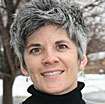Preachers are usually so close to the sermon that they do not notice gaps in thought and transitions.
It takes an intentional move to step away from the sermon in order to observe it from the point of view of the hearers. Perhaps an analogy would help describe this.
If you stand at the base of a particular mountain, you only see that mountain. But if you were to drive away from the mountain and look in your rear view mirror, you would begin to see the mountain in relation to other peaks. If you were to fly away, you would begin to see the entire range of mountains and its relation to the valleys and the surrounding terrain. Each position plays a crucial role in helping you understand the original mountain.
While you are writing your sermon, you are at the base of a mountain. You cannot see past your beautifully crafted sentences, your illustrative stories, your helpful explanations, your strong proclamations.
Take a step back in order to see the relationship of one section to another. Examine how certain words create a meaning in sentences. Are you focused on the same subject throughout a sentence? How does a sentence relate to its neighboring sentences? Is there a coherent progression from one sentence to another?
Take another step back and ask the same of your paragraphs. In addition, ask how each paragraph is in service to the overall desired function of the sermon (that is to say, how each section of the sermon does what you hope the sermon will do for the hearers). By taking one more step back, you can begin to see how the transitions in the sermon and, in fact, the whole sermon are in service to the desired function.
It is very important (note the cue!) that preachers not stay at the base of the mountain since hearers tend to have a view of the entire mountain range. By viewing the sermon some distance away, preachers become aware of what the hearers hear and, therefore, are more likely to notice unhelpful gaps in thought and transition.
While no preacher can know exactly what hearers will hear, attempting to gain the perspective of the hearer increases the audible accessibility of the sermon.
Let me recommend to you G. Robert Jacks’ book, Just Say the Word: Writing for the Ear (Eerdmanns, 1996). In this book, Jacks explains thoroughly and provides examples for his 50 “rules” for writing sermons for the ear.
Finally, a word about delivery. Manuscript preachers tend to plan (and perhaps even mark) the places they will look up from the manuscript. Let me suggest the opposite.
Rather than planning when to make eye contact with the congregation, mark the points at which you will look down at the manuscript. Hearers understand (and will appreciate the break from the intensity) that occasionally you will need to look down in order to read a quote or check your next move. The default, however, is to be fully present with your congregation.
If you discover that you have to look at the manuscript more than at your congregation, it is time to rewrite such reader-oriented sermons for the ear.

